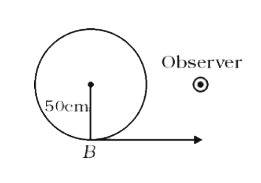What are beats ?
Video Solution
Text Solution
A periodic variation in loudness (intensity) due to superposition of two sound notes of slightly different frequencies sounded at the same time is called beats.
The time interval between successive maxima or minima of sound at a given place is called the period of beats.
The number of beats produced per unit time is called the beat frequency.
Consider two sound waves of equal amplitude (A) and slightly different frequencies n1 and n2 (with n1>n2) propagating through the same part of the medium in the same direction. These waves can be represented by the equations y1=Asin2πn1t and y2=Asin2πn2t at x=0, where y denotes the displacement of the particle of the medium from its mean position.
By the principle of superposition of waves, the resultant displacement of the particle of the medium at the point at which the two waves arrive simultaneously is the algebraic sum
y=y1+y2=Asin2πn1t+Asin2πn2t
Now, sinC+sinD=2sin(C+D2)cos(C−D2)
∴y=2Asin[2π(n1+n22)t].cos[2π(n1−n22)t]
=2Acos[2π(n1−n22)t].sin[2π(n1−n22)t]
Let R=2Acos[2π(n1−n22)t] and n=n1+n22
∴y=Rsin2πnt
The above equation shows that the resultant motion has amplitude |R| which changes periodically with time. Period of beats is the period of waxing (maximum intensity of sound) or the period of waning (minimum intensity of sound).
The intensity of sound is directly proportional to the square of the amplitude of the wave. It is maximum when |R| becomes maximum (=2A):R=−+2A.
∴cos[2π(n1−n22)t]=−+1
∴2π(n1−n22)t=0,π,2π,3π,....
∴t=0,1n1−n2,2n1−n2,3n1−n2,...
∴ Period of beats =period of waxing =1n1−n2
∴ Beat frequency =1period of beats=n1−n2
[Note : The intensity of sound is minimum (waning) when R=0.
∴cos[2π(n1−n22)t]=0
∴2π(n1−n22)t=π2,3π2,5π2,.......
∴t=12(n1−n2),32(n1−n2),52(n1−n2),.....,
∴ Period of beats=period of waning=1n1−n2
∴ Beat frequency =1period of beats=n1−n2
Thus, waxing and waning occur alternately and the period of waning equals that of waxing.]
|
Updated on:21/07/2023
Topper's Solved these Questions
- BOOK - NAVNEET PUBLICATION - MAHARASHTRA BOARDCHAPTER - DERIVATIONS-IEXERCISE - Stationary Waves5videos
DERIVATIONS-I
- BOOK - NAVNEET PUBLICATION - MAHARASHTRA BOARDCHAPTER - DERIVATIONS-IEXERCISE - Kinetic Theory of Gases and Radiation5videos
DERIVATIONS-I
- BOOK - NAVNEET PUBLICATION - MAHARASHTRA BOARDCHAPTER - DERIVATIONS-IEXERCISE - Surface Tension4videos
DERIVATIONS-I
- BOOK - NAVNEET PUBLICATION - MAHARASHTRA BOARDCHAPTER - DEFINITIONSEXERCISE - COMMUNICATION SYSTEMS3videos
DEFINITIONS
- BOOK - NAVNEET PUBLICATION - MAHARASHTRA BOARDCHAPTER - DERIVATIONS-IIEXERCISE - Assignments9videos
DERIVATIONS-II
Similar Questions
Knowledge Check
- Question 1 - Select One
What is the averages rate of the heart beats (per minute) in an adult?
A72B84C96D78 - Question 2 - Select One
A human heart beats 72 times in a minute. The beat frequency is
A1.39s−1B1.2s−1C1.42s−1D1.9s−1
(i) What is beat phenomenon?
(ii) A whistle revolves in a circle with angular velocity of ω=20rads−1. If the frequency of sound is 385 Hz and speed is 340 ms−1, then find the frequency heard by the observer when the whistle is at B.
 View Solution
View SolutionWhat is the essential condition for the formation of beats?
View SolutionWhat is a dead beat galvanometer?
View SolutionWhat is meant by beats? Discuss graphical method of beats.
View Solution(a) What is mean tby 'heart beat' ? What is the usual heart beat rate at rest ?
(b) What cahnge occurs in heart beats if a person runs for a while ? Why ?View SolutionWhat made Seibei's heart beat faster?
View Solution

